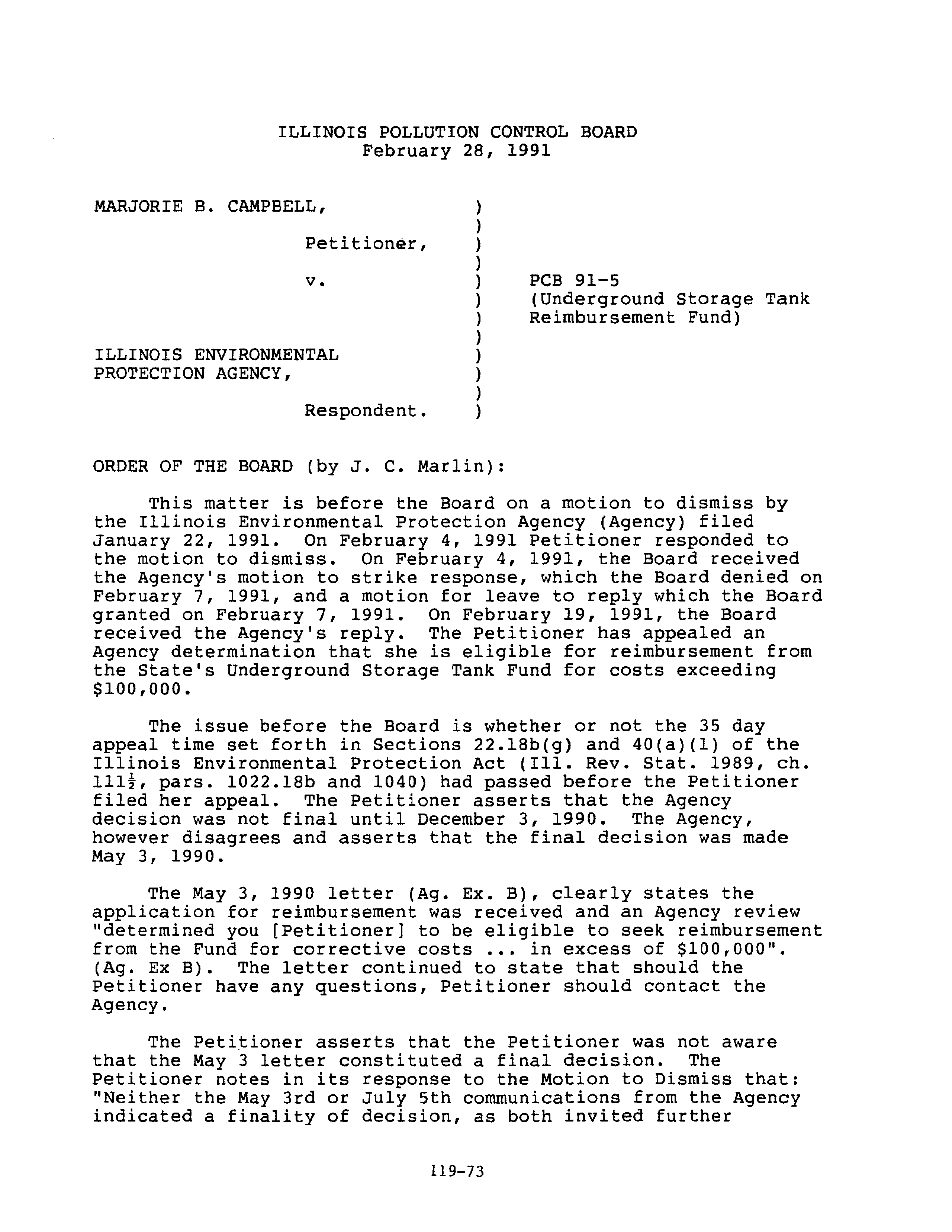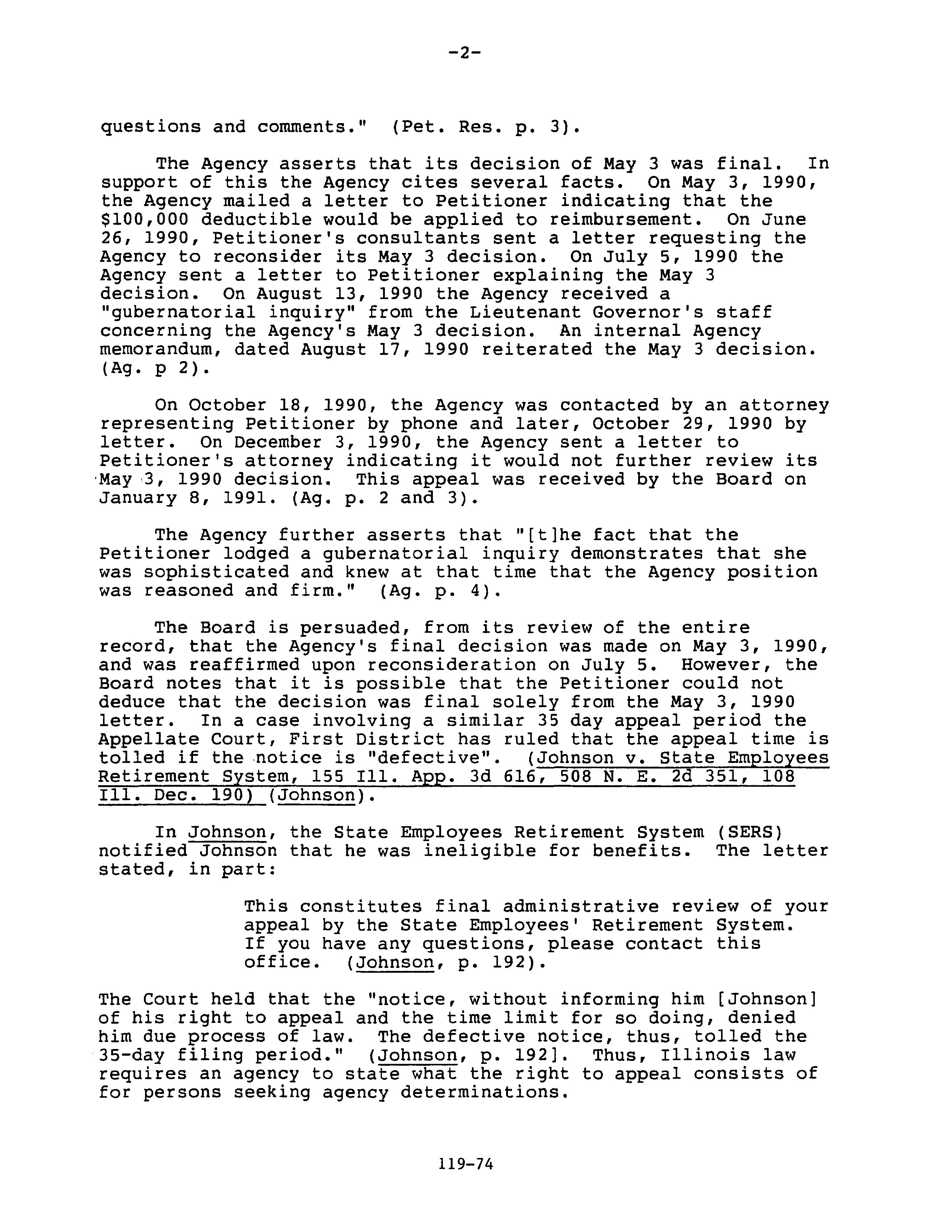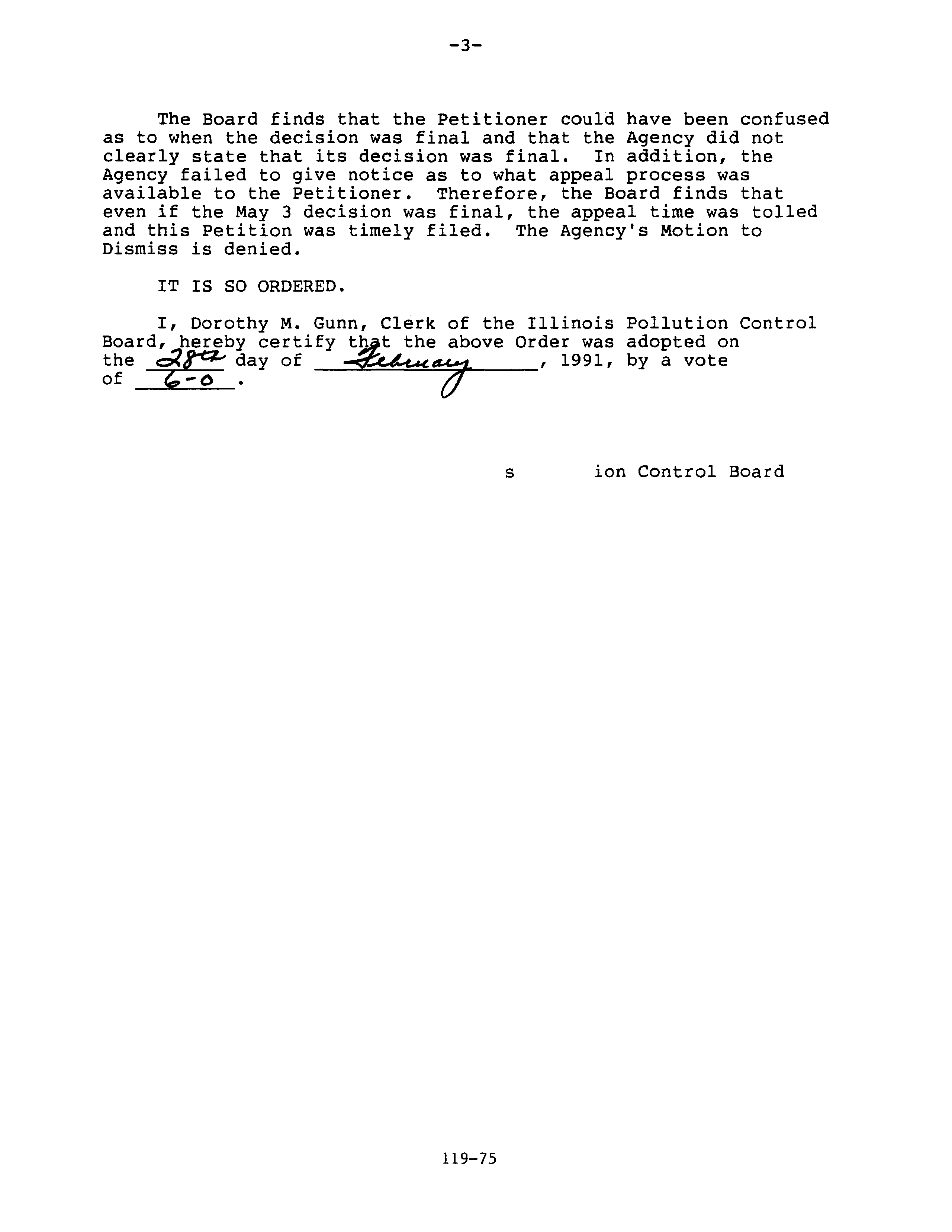ILLINOIS POLLUTION CONTROL BOARD
February 28, 1991
MARJORIE
B. CAMPBELL,
)
Petitioner,
v.
)
PCB 91—5
)
(Underground Storage Tank
Reimbursement Fund)
ILLINOIS ENVIRONMENTAL
)
PROTECTION AGENCY,
)
Respondent.
ORDER OF THE
BOARD
(by J.
C. Marlin):
This matter
is before the Board on a motion to dismiss by
the Illinois Environmental Protection Agency
(Agency) filed
January
22,
1991.
On February
4,
1991 Petitioner responded to
the motion to dismiss.
On February
4, 1991,
the Board received
the Agency’s motion to strike response, which the Board denied on
February
7,
1991, and a motion for leave to reply which the Board
granted on February
7,
1991.
On February 19,
1991, the Board
received the Agencyts reply.
The Petitioner has appealed an
Agency determination that she
is eligible for reimbursement from
the State’s Underground Storage Tank Fund for costs exceeding
$100,000.
The issue before the Board is whether or not the 35 day
appeal time set forth
in Sections 22.18b(g) and 40(a)(1)
of the
Illinois Environmental Protection Act (Ill. Rev. Stat.
1989,
ch.
1114, pars.
1022.18b and 1040) had passed before the Petitioner
filed her appeal.
The Petitioner asserts that the Agency
decision was not final until December
3,
1990.
The Agency,
however disagrees and asserts that the final decision was made
May
3,
1990.
The May 3, 1990 letter
(Ag. Ex. B), clearly states the
application for reimbursement was received and an Agency review
“determined you
Petitioner
to be eligible to seek reimbursement
from the Fund for corrective costs
...
in excess of $100,000”.
(Ag.
Ex B).
The letter continued to state that should the
Petitioner have any questions, Petitioner should contact the
Agency.
The Petitioner asserts that the Petitioner was not aware
that the May
3
letter constituted a final decision.
The
Petitioner
notes
in its response to the Motion to Dismiss that:
11Neither the May 3rd or July 5th communications from the Agency
indicated a finality of decision,
as both invited further
119—73
—2—
questions and comments.”
(Pet. Res.
p.
3).
The Agency asserts that its decision of May
3 was final.
In
support of this the Agency cites several facts.
On May 3,
1990,
the Agency mailed a letter to Petitioner indicating that the
$100,000 deductible would be applied to reimbursement.
On June
26, 1990, Petitioner’s consultants sent a letter requesting the
Agency to reconsider
its May 3 decision.
On July 5,
1990 the
Agency sent a letter
to Petitioner explaining the May
3
decision.
On August
13, 1990 the Agency received a
“gubernatorial inquiry” from the Lieutenant Governor’s staff
concerning the Agency’s May
3 decision.
An internal Agency
memorandum,
dated August
17,
1990 reiterated the May
3 decision.
(Ag. p 2).
On October
18, 1990,
the Agency was contacted by an attorney
representing Petitioner by phone and later, October
29,
1990 by
letter.
On December
3, 1990,
the Agency sent a letter to
Petitioner’s attorney indicating it would not further review its
May 3, 1990 decision.
This appeal was received by the Board on
January
8,
1991.
(Ag. p.
2 and
3).
The Agency further asserts that “~tihe fact that the
Petitioner lodged a gubernatorial inquiry demonstrates that she
was sophisticated and knew at that time that the Agency position
was reasoned and firm.”
(Ag. p.
4).
The Board
is persuaded,
from its review of the entire
record, that the Agency’s final decision was made on May 3,
1990,
and was reaffirmed upon reconsideration on July
5.
However,
the
Board notes
that it is possible that the Petitioner could not
deduce that the decision was final solely from the May 3,
1990
letter.
In a case involving a similar
35 day appeal period the
Appellate Court, First District has ruled that the appeal time
is
tolled
if the notice is “defective”.
(Johnson v. State Employees
Retirement System, 155 Ill. App.
3d 616,
508 N.
E.
2d 351, 108
Ill. Dec.
190)
(Johnson).
In Johnson, the State Employees Retirement System (SERS)
notified Johnson that he was ineligible for benefits.
The letter
stated,
in part:
This constitutes final administrative review of your
appeal by the State Employees’ Retirement System.
If you have any questions, please contact this
office.
(Johnson,
p. 192).
The Court held that the “notice, without informing him Johnson
of his right to appeal and the time limit for so doing,
denied
him due process of law.
The defective notice, thus,
tolled the
35—day filing period.”
(Johnson,
p.
192.
Thus,
Illinois law
requires an agency to state what the right to appeal consists of
for persons seeking agency determinations.
119—74
—3—
The Board finds that the Petitioner could have been confused
as to when the decision was final and that the Agency did not
clearly state that its decision was final.
In addition, the
Agency failed to give notice as to what appeal process was
available to the Petitioner.
Therefore,
the Board finds that
even if the May
3 decision was final,
the appeal time was tolled
and this Petition was timely filed.
The Agency’s Motion to
Dismiss
is denied.
IT IS SO ORDERED.
I,
Dorothy M. Gunn, Clerk of the Illinois Pollution Control
Board, hereby certify th
t the above Order was adopted on
the c~t~day of
__________________,
1991,
by a vote
of
_______.
‘7
S
ion Control Board
119—75




